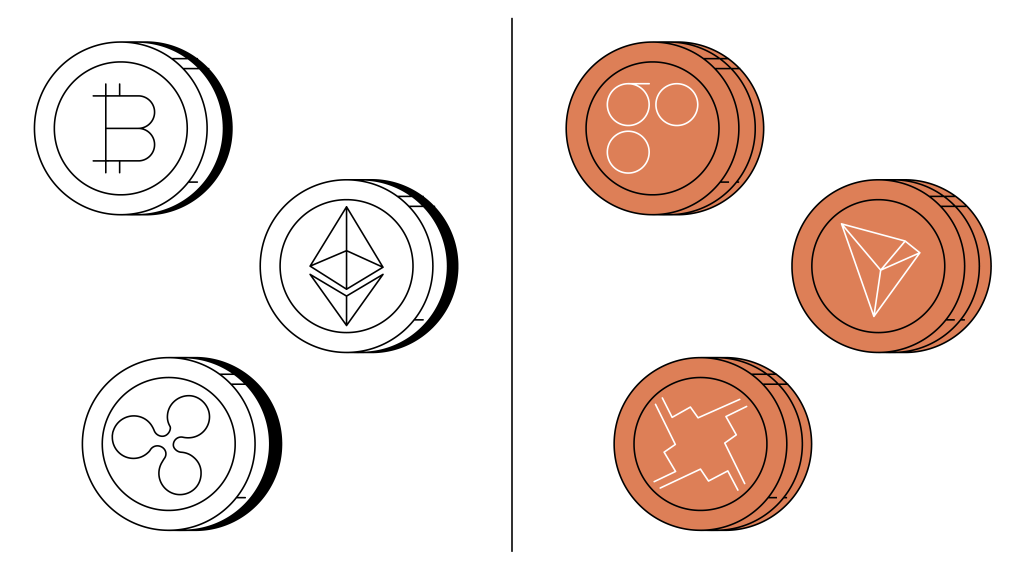Digital Assets: Cryptocurrencies vs. Crypto Tokens
It’s important not to confuse the terms “cryptocurrencies” and “tokens,” as there are fundamental differences that distinguish them.
Updated September 22, 2023 • 4 min read

Summary
The two most common blockchain-based digital assets are cryptocurrencies and tokens. The biggest differentiation between the two is that cryptocurrencies have their own blockchains, whereas crypto tokens are built on an existing blockchain.
Check out the price of cryptocurrency and tokens on Gemini
What Is a Digital Asset?
If you’re just starting out in blockchain and cryptocurrency, it’s essential to understand the difference between digital assets, cryptocurrencies, and tokens. While these terms are often used interchangeably, they are different in a number of key ways. Broadly speaking, a digital asset is a non-tangible asset that is created, traded, and stored in a digital format. In the context of blockchain, digital assets include cryptocurrency and crypto tokens.
Cryptocurrency and tokens are unique subclasses of digital assets that utilize cryptography, an advanced encryption technique that assures the authenticity of crypto assets by eradicating the possibility of counterfeiting or double-spending.
The key differentiation between the two classes of digital asset is that cryptocurrencies are the native asset of a blockchain — like BTC or ETH — whereas tokens are created as part of a platform that is built on an existing blockchain, like the many ERC-20 tokens that make up the Ethereum ecosystem.
What Is a Cryptocurrency?
A cryptocurrency is the native asset of a blockchain network that can be traded, utilized as a medium of exchange, and used as a store of value. A cryptocurrency is issued directly by the blockchain protocol on which it runs, which is why it is often referred to as a blockchain’s native currency. In many cases, cryptocurrencies are not only used to pay transaction fees on the network, but are also used to incentivize users to keep the cryptocurrency’s network secure.
Cryptocurrencies typically serve as a medium of exchange or store of value. A medium of exchange is an asset used to acquire goods or services. A store of value is an asset that can be held or exchanged for a fiat currency at a later date without incurring significant losses in terms of purchasing power.
Cryptocurrencies typically exhibit the following characteristics:
Decentralized, or at least not reliant on a central issuing authority. Instead, cryptocurrencies rely on code to manage issuance and transactions.
Built on a blockchain or other Distributed Ledger Technology (DLT), which allows participants to enforce the rules of the system in an automated, trustless fashion.
Uses cryptography to secure the cryptocurrency’s underlying structure and network system.
What Is a Crypto Token?
Tokens — which can also be referred to as crypto tokens — are units of value that blockchain-based organizations or projects develop on top of existing blockchain networks. While they often share deep compatibility with the cryptocurrencies of that network, they are a wholly different digital asset class.
Cryptocurrencies are the native asset of a specific blockchain protocol, whereas tokens are created by platforms that build on top of those blockchains. For instance, the Ethereum blockchain’s native token is ether (ETH). While ether is the cryptocurrency native to the Ethereum blockchain, there are many other different tokens that also utilize the Ethereum blockchain. Crypto tokens built using Ethereum include DAI, LINK, COMP, and CryptoKitties, among others. These tokens can serve a multitude of functions on the platforms for which they are built, including participating in decentralized finance (DeFi) mechanisms, accessing platform-specific services, and even playing games.
There are several widely used token standards for creating crypto tokens, the majority of which have been built on top of Ethereum. The most widely used token standards are ERC-20, which allows the creation of tokens that can interoperate within Ethereum’s ecosystem of decentralized apps, and ERC-721, which was designed to enable non-fungible tokens that are individually unique and cannot be interchanged with other similar tokens. As of 2020, there are hundreds of different ERC-20 tokens and thousands of ERC-721 tokens in circulation. As new tokens are developed to address blockchain’s expanding use cases, the number of different tokens likely will continue to grow at a remarkable pace.
Typically, crypto tokens are programmable, permissionless, trustless, and transparent. Programmable simply means that they run on software protocols, which are composed of smart contracts that outline the features and functions of the token and the network’s rules of engagement. Permissionless means that anyone can participate in the system without the need for special credentials. Trustless means that no one central authority controls the system; instead it runs on the rules predefined by the network protocol. And finally, transparency implies that the rules of the protocol and its transactions are viewable and verifiable by all.
While crypto tokens, like cryptocurrency, can hold value and be exchanged, they can also be designed to represent physical assets or more traditional digital assets, or a certain utility or service. For instance, there are crypto tokens that represent tangible assets such as real estate and art, as well as intangible assets such as processing power or data storage space. Tokens are also frequently used as a governance mechanism for voting on specific parameters like protocol upgrades and other decisions that dictate the future direction of various blockchain projects. The process of creating crypto tokens to serve these various functions is known as tokenization.
As the blockchain industry continues to mature, the number of unique digital assets will only continue to grow in accordance to the multifaceted needs of all ecosystem participants ranging from enterprise partners to individual users. Given that creating new assets within the digital world is less restrictive than in the physical realm, these digital assets are widely expected to improve the way countless industries operate, interact, and generate value, thereby enabling a vast array of new social and economic possibilities.
Cryptopedia does not guarantee the reliability of the Site content and shall not be held liable for any errors, omissions, or inaccuracies. The opinions and views expressed in any Cryptopedia article are solely those of the author(s) and do not reflect the opinions of Gemini or its management. The information provided on the Site is for informational purposes only, and it does not constitute an endorsement of any of the products and services discussed or investment, financial, or trading advice. A qualified professional should be consulted prior to making financial decisions. Please visit our Cryptopedia Site Policy to learn more.

Is this article helpful?
 Powered by
Powered by 


